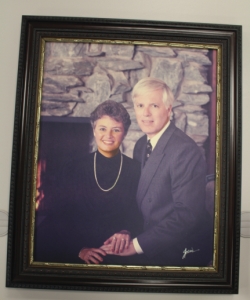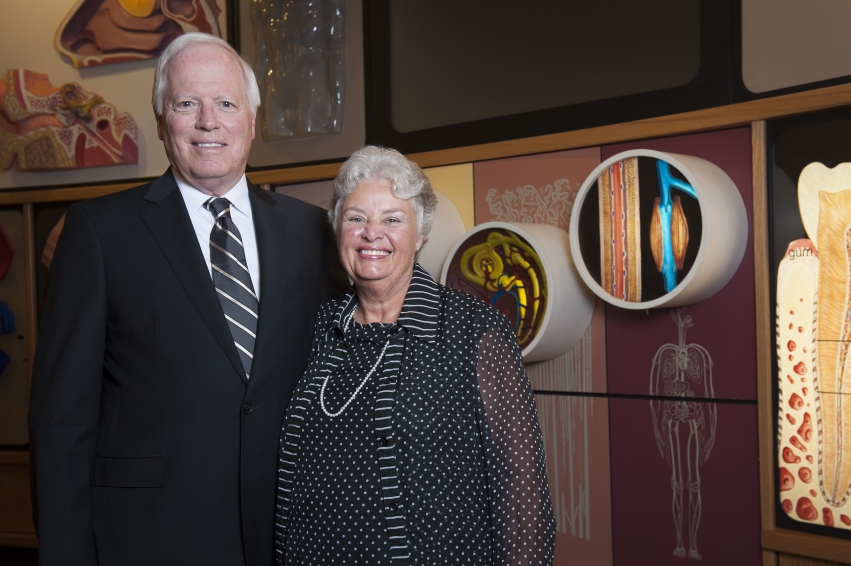
Photography by David Vernon
There’s no easy way to describe the aura surrounding Dr. Stephen and Patti Bash. Their joint charisma is charming yet humble, determined but gentle. Patti’s laugh projects pure joy and Stephen’s smile exudes sincerity, and they’re both fully aware of the power of their combined personalities.
A prolific fundraising team, they’ve used their couple’s clout to raise millions of dollars for the Peoria community and ramp up support for the causes they’re most passionate about—a long list that includes Children’s Hospital of Illinois, Heart of Illinois United Way, Hult Center for Healthy Living, Pi Beta Phi, University of Illinois College of Medicine at Peoria, Peoria Medical Society Alliance, Junior League of Peoria, Friendship House, Heartland Community Health Clinic, Race for the Cure and the Loaves & Fish feeding ministry at First United Methodist Church… among others.
Both Indiana transplants, the Bashes landed in Peoria when Stephen accepted a pediatric cardiologist position at OSF Saint Francis Medical Center in 1985. The move was quite fortuitous for Peoria. By 1990, the city had both a new community health education center—the Hult Center for Healthy Living—courtesy of Patti, a registered nurse and public health expert; and a designated Children’s Hospital of Illinois, thanks to Stephen’s expertise and efforts with other collaborators.
The parents of four and grandparents of eight, the ambitious, crusading couple has hardly slowed down as they ponder retirement plans, both consummate volunteers in their own right. It is this boundless energy they radiate—and the close relationships they have fostered over three decades in central Illinois—for which they’re so respected and revered. Having been honored with countless awards over the years, the couple remains committed to giving back for the simple belief that “If everyone does just a little bit, then the world is a better place.”
Stephen, where did you grow up?
I’m a Hoosier. My mom was from southern Indiana and my dad was from Warsaw, Indiana. He was a pediatrician, and I always wanted to go into pediatrics. I was raised in Fort Wayne, and went to Indiana University for college and then for medical school.
When I finally got to a rotation in pediatric cardiology, I fell in love with it. But I was going to go practice with my dad as a pediatrician, so I had a little bit of a conflict: pediatric cardiology doesn’t lend itself to a full-time position in a general pediatrician’s office.
I came out of medical school during the Vietnam War, 1967, and they were taking all physicians to draft… so I signed up for the “Berry plan” [a deferment program for doctors who were taking their residency]… I had to interrupt my training and go into the Navy for several years in Norfolk, Virginia. I then came back and finished my training in pediatrics, and decided to take an extra year in pediatric cardiology to give me an expertise that few people in the state of Indiana had at that time. Then I went up to Fort Wayne and was in practice with my father for 11 years, doing general pediatrics and pediatric cardiology.
What was it about pediatric cardiology that drew you in?
Stephen: I look at kids as being innocent. If you’re born with a congenital heart defect, you didn’t choose that, and the parents didn’t cause it—this is something that just happens. My passion is helping these kids. But one of the problems I have with this… I’ve gone on some mission trips, and if I see a kid with a problem and I can’t fix them, it just breaks my heart to even see them. So now I go on mission trips where I can actually do a heart catheterization, or have kids that come in from around the world where we fix them up for free. I’m very much a mechanical, physics, engineering [thinker]… Pediatrics and 3-D orientation and space just come natural to me.
So when did you decide to pursue pediatric cardiology full time?
Stephen: Back then there were only two board-certified pediatric cardiologists in the state of Indiana. They were both at Riley Children’s Hospital, and that’s whom I trained with. I was the third partially trained [pediatric cardiologist] in the state.
So I would see patients, and I would send them down to Riley for their heart catheterization surgery. After 11 years, my father began to retire, and I began to see more and more [heart] patients. I decided I really wanted to become board-certified and do it full time. So I went to what I thought was the best program in the country—and I was amazed they took me, because I was now 40 years old. It was either a new wife, a Porsche, or go back and train (laughs).
So, I kept Patti and didn’t get my Porsche, but I went down to Texas Children’s Hospital in Houston and finished my fellowship requirements, did an extra year of heart catheterizations, and then came out on the job market. We had 10 spots we were looking at; I had Peoria ranked last.
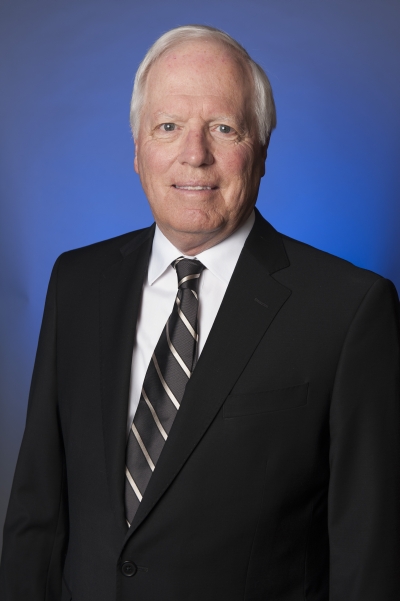 Patti: Can we back up for just a second? There were only about 300 practicing pediatric cardiologists at that time [in the U.S.]. Fortunately, he had job offers all around, but most of them were in big cities.
Patti: Can we back up for just a second? There were only about 300 practicing pediatric cardiologists at that time [in the U.S.]. Fortunately, he had job offers all around, but most of them were in big cities.
Stephen: Bill Albers [Dr. William Albers of OSF Saint Francis Medical Center] had heard me [present] a paper down in Miami at a national meeting and invited me to Peoria. [Patti and I] had everything ranked… but we decided to go and visit all 10 spots and have an open mind about it. I ended up putting [Peoria] first.
We were only five hours away from our family in Indiana, and Saint Francis had the largest pediatric program in town… They had a medical school here that had just started, a residency program in pediatrics, which was very good, and Bill Albers was just phenomenal. [Dr. Jitendra] J. Shah was his partner, and I became the third pediatric cardiologist [at OSF].
How was the transition to life in Peoria?
Stephen: When I got here, I lived 10 minutes from work, and I never could afford this home in Houston. I commuted an hour and a half each way in Houston with the traffic; it’s horrible. I had loved the research, and it was a huge program—probably the largest in the country—but I was known as a “phantom father” for two years. We had four kids; Patti raised them. I left before they were awake in the morning, and I came home after they were in bed. It just wasn’t right. Here, I had my cake and kind of ate it too, in a sense.
So how did Children’s Hospital of Illinois get started?
Stephen: I talked to Dr. Albers, and I said, you know, we really should have a children’s hospital here. What if we did a hospital within a hospital? It’s not a big construction project. But we should hire an administrator, have a children’s hospital board, get a name and then promote ourselves as a children’s hospital. Well, he bought into that, and by 1990 we had a children’s hospital. It was a hospital within a hospital, patterned after Vanderbilt [The Monroe Carell Jr. Children's Hospital, affiliated with Vanderbilt University Medical Center in Nashville, Tennessee]. We actually flew down there and got our ideas on how to set it up through them.
[The Milestone Project] opened up in 2010, and it was a big deal. It was a $280 million project, and we were able to raise close to $80 million from this community for it. We didn’t get all of the pediatrics in one spot, but we got the vast majority of it—and new cath labs, operating suites and an entrance... all in one place.
We outgrew it within a year of it opening up, but the growth has been phenomenal. When I came here in 1985, there were 15 pediatric subspecialists—and now there are about 135. And why do people come here? Why do they want to be specialists here? It’s because of the Children’s Hospital and the association with the school and residency programs. It’s grown much larger than I ever expected, and we still have more growth to do.
I imagine the cardiology field has changed a lot over the years.
Stephen: When I started out, there were a lot of kids that we just couldn’t help fix. Their hearts were so bad… all those kids [who] died in the history of mankind. Well, in 1985 we started saving these kids. So now I’ve got 30-year-olds who never used to live, that I can’t turn over to anybody. Adult cardiologists have no idea what to do with them… So where I used to just take care of infants and children, now we take care of patients through all ages [at the] Congenital Heart Center.
Patti: Every advancement in pediatric cardiology has been made in his lifetime, except for one.
Stephen: It’s called the patent ductus arteriosis [a congenital heart defect]. The first one was ligated before I was born. But everything else—all the open-heart surgeries, all the cardiovascular ICUs, heart catheterizations, heart lung machines—all that was in one lifetime, my lifetime.
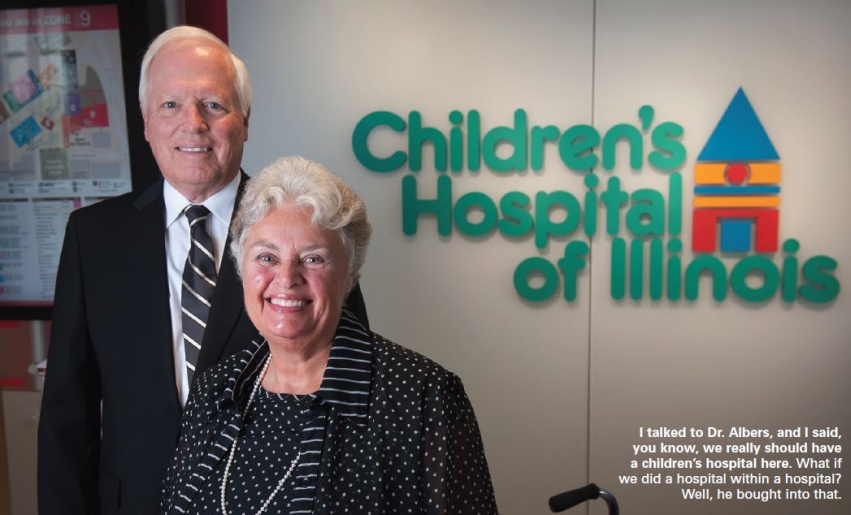
Patti, you’ve also been very involved with Children’s Hospital of Illinois.
Patti: Stephen and I have both been involved with Children’s Hospital since its inception in 1990. We’ve served on the board all these years, and we’ve loved it.
Stephen: And we’ve been real big fundraisers for the hospital. We endowed the first chair in pediatrics in the University of Illinois system—that was over a million dollars raised. But what’s neat about us is that Patti bought into all my dreams about the Children’s Hospital and has been a very staunch supporter all the way, and I’ve tried to buy into all her dreams at Hult. We have complemented each other, which has really made it nice.
That sounds like a good marriage.
Patti: It is. Almost 50 years! (laughing)
Stephen: If we can make it to November (smiling).
Patti, are you also from Indiana?
Patti: I am. I grew up in a little town called Muncie. My mother was very philanthropic. She was involved in many things, so I kind of grew up knowing that you gave back. I remember, even in middle school, chairing campaigns (laughs). I love to raise money for a cause that my heart is passionate about, so I think I learned by example that way. I’ve always been a joiner, and I like organization. Wherever we’ve moved, I’ve always gotten involved in the community.
I really believe in voluntarism. I think when you’ve been given a lot, you need to give back. I guess I give for a lot of reasons, but probably the most important one is because of my faith, and I think it’s been a good example for my children and for my grandchildren. Plus, it’s a wonderful way to make friends. We have a great community here in Peoria, and it’s just been fun to be involved in that.
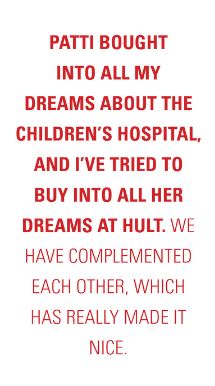 Stephen: She only fundraises for projects she really believes in.
Stephen: She only fundraises for projects she really believes in.
Patti: Steve makes the money, and I give it away, much to his chagrin (laughs).
So how did you two meet?
Stephen: We were five years apart… I was in medical school and she was a sophomore in college. Her freshman year was at [Indiana University’s] Bloomington [campus], but then she came up her sophomore year for nursing school at Riley. So I was walking down at Riley and… I spotted her and thought, she looks nice. But I didn’t say anything to her then. I saw her again in the library…
Patti: About three weeks later.
Stephen: I went over to her, and she had a Pi Phi [Pi Beta Phi] pin on. Well, my mom’s a Pi Phi, my sister’s a Pi Phi, my grandmother’s a Pi Phi…
Patti: All your aunts…
Stephen: We have 18 Pi Phis in my family.
Patti: It was a good thing I was a Pi Phi! (laughing) …We got married halfway through my senior year.
Stephen: Her senior year was my year away on pediatric internship in Rochester.
Patti: The two deans of the nursing schools worked together so I could go back and graduate with my class. Really, that’s what’s shaped my whole life. It was very serendipitous, because public health nursing at Indiana was their [least strong program]. Indiana [University] was an excellent school of nursing, but in Rochester, that program [public health sciences] was their best.
And so, that was my last semester, and I found I loved teaching and working with low-income people. So Loaves & Fish—the feeding program at our church—stemmed from that. And my education background in helping to start a public health center in Fort Wayne and then here, really came from my love for teaching. It’s interesting how things work out—God has a hand in it.
So what prompted the start of the Hult Center for Healthy Living [formerly the Hult Health Education Center]?
Patti: It made a lot of sense for me to try to duplicate what we had done in Fort Wayne [as a teacher specialist at the Harold W. McMillen Center for Health Education]… I got involved in the Medical Society Alliance and spoke at their meeting about this concept of a health education center. It was a neat approach to substance abuse prevention and pregnancy prevention.
In the ‘80s, because of the economy… people were leaving Peoria. In fact, there were bumper stickers that said, “Will the last person out please turn off the lights?” [Mayor] Jim Maloof had started several different committees in order to revitalize Peoria and give people hope. So I spoke to them, and this medical group adopted the idea of a health education center.
Dr. Dick [Richard] Lister, a neurosurgeon, was very involved in the community and knew who we needed to speak to. For instance, we went to [local philanthropist] Bill Rutherford with a proposal right at the beginning. He said, “Patti, I want you to look under my table. You see all those baskets full of proposals? Yours is the most exciting one I’ve ever had.”
We took a bunch of community leaders over to Fort Wayne to see the community health center there in action, and on the way back, everyone was so excited. Bill Rutherford said he’d do all the paperwork and incorporate us for free… At the same time, Frank Bussone—head of the foundation at Proctor—was a friend of Marvin Hult’s, the name benefactor of this health center. Marv wanted to do something significant with his life. He made a very significant donation to us, and that’s how we got started.
Stephen: And he was very tied into Proctor, so that’s how we got the land.
Patti: People were hungry for something that would make a difference in our community. It was just a privilege to be a part of that without knowing anyone. But I think my strength is in being a cheerleader and surrounding myself with people who can help make something happen.
How has the need for health education programming in Peoria changed since former Mayor Jim Maloof first prioritized it back in 1986?
Patti: The needs have changed, but the basic principles are the same. Eating well, getting plenty of rest, staying away from chemicals that can hurt your body, exercising…
Stephen: And the health center displays that all in a very dynamic way.
Patti: The health center has expanded… Now we do a lot of suicide prevention, mental health in the schools and a lot of cancer [prevention programs] like tai chi, massage and nutrition. So, it’s much bigger than I anticipated. There are four pillars: cancer and mental health, senior education and youth education, which is what I really started… In Fort Wayne, I wrote a health curriculum where my kids went to school. I love children, so being in health education and in schools with kids was the perfect job for me.
Tell us more about the Loaves & Fish program you started at First United Methodist Church.
Patti: (laughing) That’s a funny story. We were asked to chair a committee called “Church and Society,” which was defunct. It hadn’t met for 15 years because it was politically charged. So we went to our pastor and said we’d be happy to chair it, but only if we could do things. So, we did petitions and blood drives, but my heart always wanted to feed the hungry, because I always saw it as such a need.
Around that time, I got a call from Hobe Albright, one of the founders of Heart of Illinois Harvest. He said, “I had a dream that we were going to have a feeding site in the center of the city, and I thought your church would be the perfect place, and you would be the perfect person.” I had no idea who this man was! (laughing) So we decided, with this little committee, that we were going to feed the hungry.
Well, now we’re feeding 250 to 350 people every Saturday… And it’s expanded from just a feeding program. We have a clothing locker; a free medical clinic every Saturday; a Saturday worship service; Common Place does literary education; and lots of ancillary things, like HIV testing, [haircuts]… medical students come each week now and do blood pressure and vitals… We average 60 volunteers now every Saturday.
Stephen: And they come from all over: apostolic churches, Jewish [synagogues], Mormon [churches]… It’s very ecumenical.
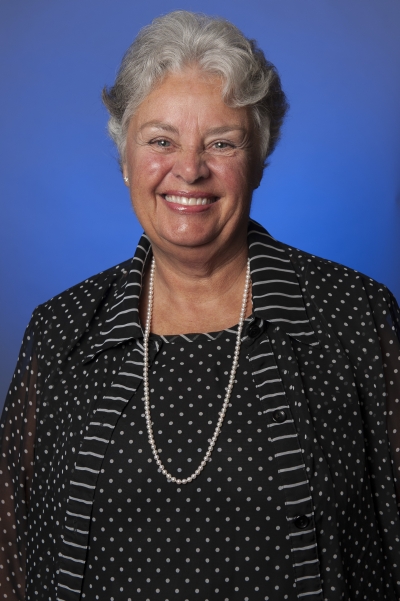 Patti: It’s a wonderful program. I coordinate the coordinators, and every time I work I come home feeling exhausted, but thrilled. We have a lot of homeless guests, chemically dependent, mentally ill, people just down on their luck, and about a fourth of them are children.
Patti: It’s a wonderful program. I coordinate the coordinators, and every time I work I come home feeling exhausted, but thrilled. We have a lot of homeless guests, chemically dependent, mentally ill, people just down on their luck, and about a fourth of them are children.
Stephen: If I’m with Patti, I can walk down the darkest alley in the worst part of town and we’d be fine, because she’d just say, “Oh hi!”(laughs)
Patti: The reason I love our church is because of their outreach… and everyone is welcome. It’s got a very tender heart in the heart of the city.
Are you ever going to retire, Stephen?
Stephen: (smiles) I’m going to have to retire. It’s coming. I don’t know when. It’ll be very hard for me.
Patti: He loves what he does.
Stephen: My main goal in terms of the hospital is to see the Congenital Heart Center grow and continue after I’m gone, and to have the Children’s Hospital grow. Whatever I can do now with my declining time is to allow them to survive, just like Patti wants the Hult Center to survive.
Patti: And I’m still over there a lot. I don’t teach for them anymore, but I volunteer.
Stephen: I don't know about this retirement thing: she’s busier now than she was when she was working! (laughs)
Of everything you’ll leave behind, what do you want to be most remembered for?
Stephen: From my perspective, about the Children’s Hospital… it’s what it does for the kids, and I’m very content with it. It isn’t going to be the Steve Bash Children’s Hospital. It’s going to be the Children's Hospital of Illinois—and growing and thriving years from now.
Patti: I go along with what he said. No one will know that I did the Hult Center, or Loaves & Fish, but I guess it’s more subtle than that. I just want to feel like I made a difference in this world. If I have a legacy, it’s probably motivating other people to be involved in voluntarism. If everyone does just a little bit, then the world is a better place. And I just would like to think that I’m pleasing God in what I’ve done and have been helpful to other human beings, that I’ve been a good example to my kids and grandchildren to give back.
Stephen: People ask me, is Patti like this all the time? Because she’s always so bubbly and cheerful. And she is. She’s not a Pollyanna. She has a very positive outlook.
Patti: I guess I would like to be thought of as just doing what I could in my own little way to make a difference… It’s a good life, and it’s a great community. We are just very blessed. iBi

